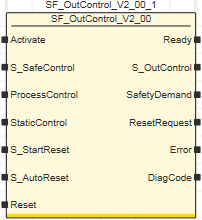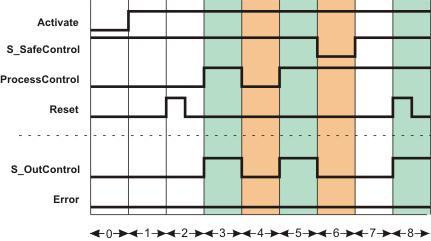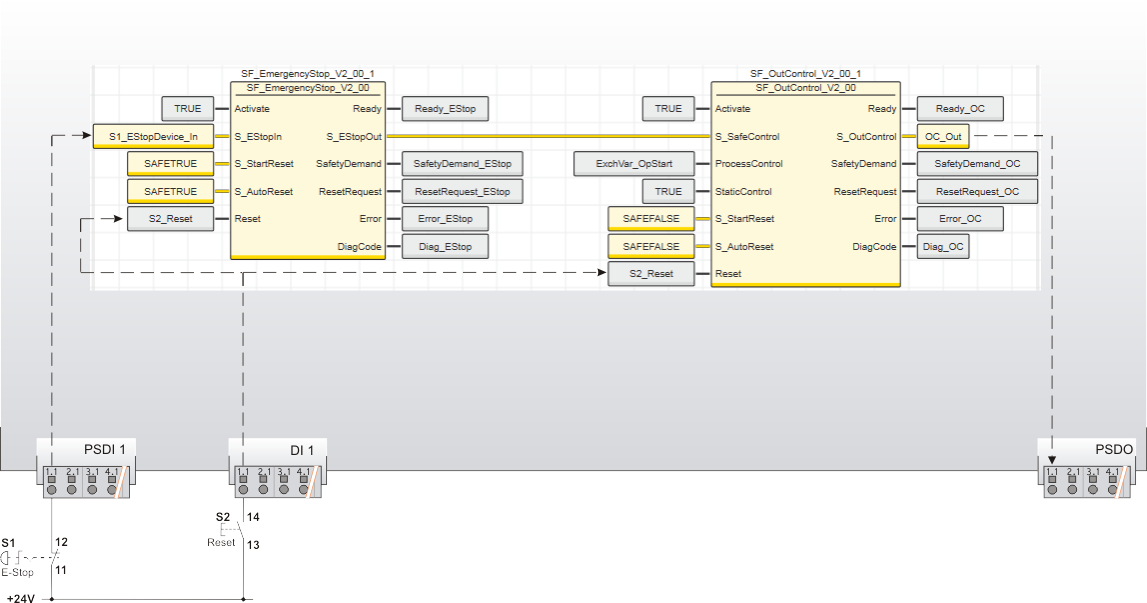SF_OutControl
Help version 1.1 / Issue date: 2018.03
The following description is valid for the function block SF_OutContrl_V2_0z, Version 2.0z (where z = 0 to 9).
| Short Description | The safety-related SF_OutControl function block controls the output of a safety-related device. The safety-related output is controlled depending on a signal from the standard controller (operation start/stop) and a safety-related signal (monitoring of a safety-related function, e.g., emergency-stop). S_StartReset can be used to specify a start-up inhibit and S_AutoReset can be used to specify a restart inhibit. Both inhibits refer to the start or restart of the Safety PLC or safety-related function. Furthermore, the StaticControl input enables the specification of an additionally required operation stop of the standard controller with requested safety-related function and before activating the function block. | |||||||||||||||||||||||||||||||||||
| Block Icon |  |
|||||||||||||||||||||||||||||||||||
| Inputs |  Activate Activate
Refer to the topic "Activate" for details.  S_SafeControl S_SafeControl
Refer to the topic "S_SafeControl" for details.  ProcessControl ProcessControl
Refer to the topic "ProcessControl" for details.  StaticControl StaticControl
Refer to the topic "StaticControl" for details.  S_StartReset
S_StartReset
The start-up inhibit and/or restart inhibit must only be deactivated if it is certain that starting up/restarting the machine/system will not lead to a hazardous situation or that a suitable start-up/restart inhibit is in place at another location or using other means.
Refer to the topic "S_StartReset" for details.  S_AutoReset S_AutoReset
The start-up inhibit and/or restart inhibit must only be deactivated if it is certain that starting up/restarting the machine/system will not lead to a hazardous situation or that a suitable start-up/restart inhibit is in place at another location or using other means.
Refer to the topic "S_AutoReset" for details.  Reset
Reset
Resetting the function block by means of a positive signal edge at the Reset input can cause the S_OutControl output to switch to SAFETRUE immediately (depending on the status of the other inputs).
Refer to the topic "Reset" for details. |
|||||||||||||||||||||||||||||||||||
| Outputs |  Ready
Ready
Refer to the topic "Ready" for details.  S_OutControl S_OutControl
Refer to the topic "S_OutControl" for details.  SafetyDemand SafetyDemand
Refer to the topic "SafetyDemand" for details.  ResetRequest ResetRequest
Refer to the topic "ResetRequest" for details.  Error
Error
Refer to the topic "Error" for details.  DiagCode DiagCode
Refer to the topic "DiagCode" for details. |
|||||||||||||||||||||||||||||||||||
| Detailed information |  Signal sequence diagram Signal sequence diagram
This diagram relates to a typical output control with specified start-up inhibit and restart inhibit. No additionally required operation stop of the standard controller is configured.
 Application example Application example
This example shows the control of a safety-related output with the safety-related SF_OutControl function block. The TRUE constant at the StaticControl input specifies that no additional operation stop of the standard controller is required. All function blocks involved are perpetually activated by means of TRUE constants at the Activate input. An emergency-stop control device S1 is connected as single-channel to the input terminal 1.1 of the safety-related input device PSDI 1 and assigned to the global I/O variable S1_EStopDevice_In. This global I/O variable is connected to the S_EStopIn function block input of the SF_EmergencyStop function block. Neither a start-up inhibit nor a restart inhibit is specified for the SF_EmergencyStop function block (SAFETRUE constant at both inputs S_StartReset and S_AutoReset). Instead, both inhibits are configured at the SF_OutControl function block: The S_StartReset = SAFEFALSE input specifies a start-up inhibit after the Safety PLC has been started up or the function block has been activated. S_AutoReset = SAFEFALSE configures a restart inhibit after the request for the safety-related function has been removed, i.e., after the SAFETRUE signal has returned at the S_SafeControl function block input. Both inhibits are only removed when there is a positive signal edge at the Reset input. To this end, the S2 reset button is connected to input 1.1 of the standard input device DI 1. Its signal is assigned to the global I/O variable S2_Reset, which is connected to the Reset input of the SF_OutControl function block. Further connection of the SF_OutControl function block:
 Function block instantiation Function block instantiation
The IEC 61131-3 standard defines function block instantiation. Instantiation means, a function block is defined once and can be used (instantiated) several times. This applies to all FBs (user-defined POUs as well as library FBs, such as IEC standard FBs, firmware FBs, user library FBs).
Why instantiation? The following applies:
The user-defined function block 'TLC' ("Two Level Controller") is added to the 'Functions & Function Blocks' category (COMPONENTS area). It shall be called twice in the program POU 'Container' to control the filling level and the temperature of a boiler. For both FB instances, an instance name declaration is added to the 'Variables' table of the calling program POU 'Container': TLCTemperature and TLCLevel. Thus the 'TLC' function block can be called twice in the code worksheet of the calling POU by means of these instance names. |


